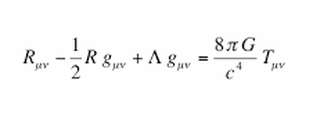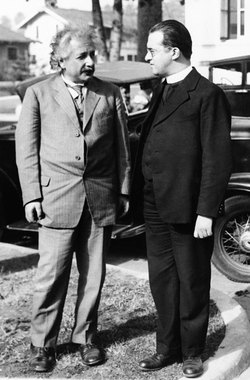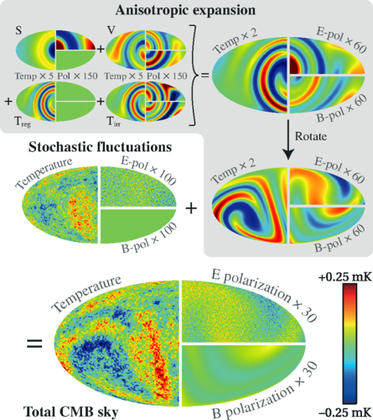|
A recent paper published in Physical Review Letters puts new limits to the isotropy observed in the Universe, taking Copernicus' principle to be valid with more resolution than ever before.  Einstein's equations of general relativity. Einstein's equations of general relativity. In my last year as an undergrad in college I took a general relativity course, I remember we spent two months studying cosmology. One of the first principles we were told of, was that the Universe is considered to be homogeneous and isotropic. This principle was assumed by Friedman, by Lemaitre, by Robertson and by Walker in what became known as the FLRW cosmological model. General relativity implies complex equations, 10 indeed, that are coupled to each other, and they cannot be solved in an analytical way unless we do some assumptions of symmetry to simplify them. Homogeneity and isotropy are two very reasonable ones. Although we see stars in particular positions and directions, at a great scale, all points in the universe and all directions seem equal, there is no preferred direction or placed in the Universe.  Albert Einstein and George Lemaitre. Albert Einstein and George Lemaitre. This is not easy so verify observationally, or at least not in the 1930s, when cosmology was appearing to stage. But, nevertheless, assuming a homogeneous and isotropic universe has given a great success in describing it. Predictions based in FLRW cosmological models, on the composition and evolution of the universe, have been a great test to the assumptions. In the last two decades, thanks to the new observational data from the COBE, WMAP, and Planck space telescopes, some previous results have been verified with higher accuracy than ever before, such as the Cosmic Microwave Background radiation, or the composition of the universe. But these observations have also given birth to new questions, not easy to respond. Cosmology has incorporated new ingredients such as dark matter and dark energy. These are accepted by an important portion of the cosmology community, but there are other scientists that believe that there are no dark matter and/or dark energy, and the answer is in a different focus. There are important scientists trying to modify Einstein's equation of relativity to explain why the universe seems to be expending an an increasing rate, for example. Other researchers were assuming that the universe does not contain dark energy, instead, the observations have been ill-interpreted due to assuming that the universe is homogeneous and isotropic. Having some preferred directions could help explain the observations without needing to include the dark sector.  In this recent publication, a research group in London, has analyzed data from the space telescopes concluding that the universe is highly isotropic. They have assumed that the universe, while still homogeneous, be non-isotropic. These assumptions lead to solutions of Einstein's equations known as Bianchi cosmologies. There are several of these posible solutions depending on the types of non-isotropy considered. Using data from the cosmic microwave background temperature and the polarization from the Planck satellite, the researchers conclude that the universe is very unlikely anisotropic. In the figure they represent the inhomogeneity pattern in the cosmic microwave background that would arise due to small anisotropic expansion of the universe. The authors constrain all model of the anisotropic expansion. Each map of the universe (each elipse) shows the temperature, the electric polarization (E), and magnetic polarization (B), these last magnified 30 times to see the inhomogeneities. Their results, after comparing the numerical simulations with the observations, point that the probability of having a non-isotropic universe is of 1 in more than one hundred thousand.
24 Comments
5/9/2022 14:06:48
Really informative article, I had the opportunity to learn a lot, thank you. https://freecodezilla.net/woodmart-wordpress-theme/
Reply
11/9/2022 17:58:49
Really informative article, I had the opportunity to learn a lot, thank you. https://kurma.website/
Reply
14/9/2022 18:21:37
Really informative article, I had the opportunity to learn a lot, thank you. https://bit.ly/site-kurma
Reply
30/9/2022 08:36:28
It's great to have this type of content. Good luck with your spirit. Thank you. https://bit.ly/site-kurma
Reply
4/10/2022 20:25:36
I think this post is useful for people. It has been very useful for me. Looking forward to the next one, thank you. https://escortnova.com/escort-ilanlari/rize-escort/findikli-escort/
Reply
6/10/2022 04:40:34
I follow your posts closely. I can find it thanks to your reliable share. Thank you. https://escortnova.com/escort-ilanlari/mus-escort/korkut-escort/
Reply
6/10/2022 08:42:36
I support your continuation of your posts. I will be happy as new posts come. Thank you. https://escortnova.com/escort-ilanlari/konya-escort/tuzlukcu-escort/
Reply
7/10/2022 06:36:49
I think the content is at a successful level. It adds enough information. Thank you. https://escortnova.com/escort-ilanlari/gaziantep-escort/oguzeli-escort/
Reply
8/10/2022 11:08:36
Thoughtful and real content is shared. Thank you for these shares. https://escortnova.com/escort-ilanlari/antalya-escort/serik-escort/
Reply
23/11/2022 22:28:55
Tıkla evde calismaya basla: https://sites.google.com/view/evden-ek-is/
Reply
11/12/2022 15:16:03
Uygun fiyatlardan takipçi satın al: https://takipcialdim.com/
Reply
11/12/2022 17:11:32
Garantili Tiktok takipçi satın al: https://takipcialdim.com/tiktok-takipci-satin-al/
Reply
11/12/2022 17:14:16
instagram beğeni satın al: https://takipcialdim.com/instagram-begeni-satin-al/
Reply
17/12/2022 09:19:56
uygun fiyatlardan takipçi Hemen Göz At: https://takipcim.com.tr/
Reply
Leave a Reply. |
Andrés AragonesesPhysicist, working in quantum optics and nonlinear dynamics in optical systems. Loves to communicate science. Archives
January 2018
Categories |
 RSS Feed
RSS Feed
